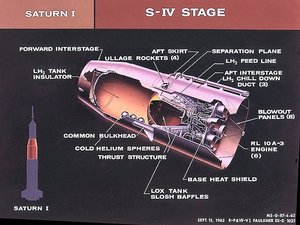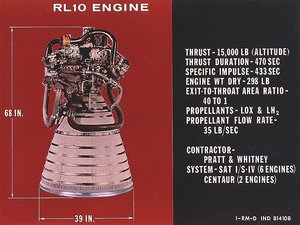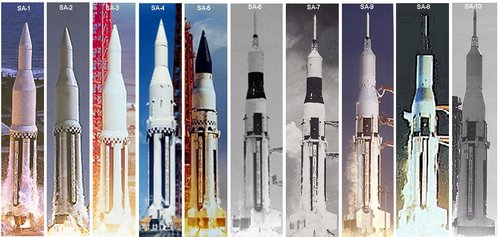Saturn I
|
|
| Saturn I | ||
|---|---|---|
| Missing image SA-1_launch.jpg The first Saturn I launched October 27, 1961. | ||
| Stages | 2 or 3 | |
| 1 - S-I | Engines | 8 * H-1 |
| Thrust | 1,500,000 lbf (6.7 MN) | |
| Burn time | ~150 seconds | |
| Fuels | RP-1/LOX | |
| 2 - S-IV | Engines | 6 * RL-10 |
| Thrust | 90,000 lbf (400 kN) | |
| Burn time | ~482 seconds | |
| Fuels | LH2/LOX | |
| 3 - Centaur C | Engines | 2 * RL-10 |
| Thrust | 30,000 lbf (133 kN) | |
| Burn time | ~430 seconds | |
| Fuels | LH2/LOX | |
| Two stage version | ||
| Payload to LEO | 9,000 kg | |
| Payload to TLI | 2,200 kg | |
| Three stage version | ||
| Payload to LEO | ? kg | |
| Payload to TLI | ? kg | |
The Saturn I was America's first large clustered rocket. Its tanks were derived from the Jupiter and Redstone missile tanks, and its first stage engines were derived from those of the SM-64 Navaho missile. An earlier version of the H-1 engine was also used by the Thor and Jupiter IRBM's. It was conceived in April 1957 by Dr. Wernher von Braun and the U.S. Army Ballistic Missile Agency (ABMA) clustered launch vehicle for carrying manned and unmanned space payloads with a thrust of 1.5 million lbf (6.7 MN). Initial plans called for 30 research and development flights between 1958 and 1963.The final production run however, resulted in the launch of only 10 Saturn I vehicles. The program along with U.S. Army Ballistic Missile Agency (ABMA) personnel were tranfered to NASA in 1960.
The Saturn I started out in April 1957 as a heavy lift concept called the Juno V by the U.S. Army Ballistic Missile Agency. It was later renamed the Saturn in February 1959. It was designed to be manufactured using existing tooling from Redstone MRBM and Jupiter IRBM missiles. It also used eight modified Thor IRBM/Jupiter IRBM, S-3D, rocket engines. The modified engine was called the H-1 rocket engine. In designing the Saturn I, the ABMA was trying to meet the anticipated needs of the Department of Defense for heavy lift of newer military satellites in the 1960 – 1962 time frame. The ABMA considered the Juno V as a general carrier vehicle for research and development of "offensive and defensive space weapons." Certain specific tasks were forecast for each of the military services, including navigation satellites for the Navy; reconnaissance, communications, and meteorological satellites for the Army and Air Force; support for Air Force manned missions; and surface-to-surface supply for the Army at distances up to 6400 kilometers. For NASA, the ABMA planners considered the possibilities of the Juno V in support of satellites, space probes, and space stations, as well as a test bed for a 6.7 MN (1.5 million lbf) engine and other propulsion systems.
In the end, the Department of Defense decided that the Saturn was simply too big and expensive for any military mission, and that included men in space. They also thought that big boosters of the Saturn class should be NASA's responsibility because there was no urgent military application for them. The ABMA was transferred to NASA on July 1, 1960, and the Saturn became part of the Apollo program. The Department of Defense turned to the Titan family of rockets for its heavy lift needs, in the form of the Titan III and Titan IV. A Titan III has about the same lift capability of a Saturn IB, but costs less to manufacture and launch.
The main payload of the Saturn I was the Apollo Spacecraft.
Further development led to the Saturn IB and Saturn V rockets.
Data for the Original Saturn I
| Parameter | S-I - 1st Stage | S-IV - 2nd Stage | S-V - 3rd Stage |
|---|---|---|---|
| Height (m) | 24.48 | 12.19 | 9.14 |
| Diameter (m) | 6.52 | 5.49 | 3.05 |
| Gross mass (kg) | 432,681 | 50,576 | 15,600 |
| Empty mass (kg) | 45,267 | 5,217 | 1,996 |
| Engines | Eight - H-1 | Six - RL-10 | Two - RL-10 |
| Thrust (kN) | 7,582 | 400 | 133 |
| ISP (lbf·s/lb) | 288 | 410 | 425 |
| ISP (kN·s/kg) | 2.82 | 4.02 | 4.17 |
| Burn duration (s) | 150 | 482 | 430 |
| Propellant | LOX/RP-1 | LOX/LH2 | LOX/LH2 |
Saturn I - Block II Launch Events
| Launch Event | Time (s) | Altitude (km) | Range (km) |
|---|---|---|---|
| Ignition Command | -3.02 | . | . |
| Commit | 0.04 | . | . |
| First Motion | 0.17 | . | . |
| Liftoff | 0.40 | . | . |
| Guidance Computer Release | 0.43 | . | . |
| Begin Roll Maneuver | 8.40 | . | . |
| End Roll Maneuver | 13.40 | . | . |
| Begin Tilt | 15.40 | . | . |
| Mach One | 55.24 | 7.18 | . |
| Max Q | 73.00 | 13.53 | . |
| S-IV LH2 Prestart | 107.00 | . | . |
| Freeze Tilt | 134.40 | . | . |
| S-IV LOX Prestart | 138.47 | . | . |
| Inboard Engine Cutoff | 140.24 | 78.35 | 67.31 |
| Outboard Engine Cutoff | 146.24 | 88.08 | 79.54 |
| Ullage Rocket Ignition | 146.56 | . | . |
| S-I / S-IV Separation | 146.64 | . | . |
| Retro Rocket Ignition | 146.71 | . | . |
| S-IV Ignition | 148.34 | . | . |
| Jettison Ullage / LES | 158.64 | . | . |
| Switch Platforms (ST-90S to ST0124) | 160.64 | . | . |
| Resume Tilt | 164.24 | . | . |
| Stop Tilt | 623.93 | . | . |
| S-IV Cutoff | 625.93 | 509.64 | 1856.39 |
| Orbit Insertion | 635.93 | . | . |
S-I stage
Saturn_I_test_article.jpg
The S-I is an eight engine first stage rocket booster. It is composed of nine propellant containers, eight fins, a thrust structure assembly, eight H-1 rocket engines, and many other components. The propellant containers consist of eight Redstone tanks. Four holding LOX — painted white; and four holding RP-1 — painted black. They are clustered around a central Jupiter rocket tank, which contains LOX. The four outboard engines can gimble, meaning they can be steered to properly guide the rocket. This requires a few more engine components.
S-I_rocket_stage.jpg
Here are the specifications:
Height: 24.48 m
Diameter: 6.52 m
Engines: 8 H-1
Thrust: 1,600,000 lbf (7.1 MN)
Fuel: RP-1 (Refined kerosene) 41,000 US gal (155 m³)
Oxidizer: Liquid oxygen (LOX) 66,000 US gal (250 m³)
Burn time: 2.5 min
Burnout altitude: 42 miles (68 km)
H-1 engine
H-1_rocket_engine.jpg
The H-1 engine is a 200,000 lbf (890 kN) thrust LOX/RP-1 engine, used alone in the first stages of some Delta rockets and the Jupiter rocket. It is derived from the Navaho missile, and was simplified and improved for S-IB use. It is used in clusters on all S-IB rocket stages. Later it would be uprated to 205,000 lbf (912 kN) of thrust. The H-1 preceded the F-1 engine, which was used on the Saturn V rocket. Here are the basic data:
Fuel: RP-1 (refined kerosene)
Oxidizer: liquid oxygen (LOX)
Height: 8.5 ft (2.6 m)
Width: 5.5 ft (1.7 m)
Thrust: 200,000 lbf (890 kN)
Uprated thrust: 205,000 lbf (912 kN)
Fuel flowrate: 2092 US gal/min (132 L/s)
Oxidizer flowrate: 3330 US gal/min (210 L/s)
Oxidizer to fuel ratio: 2.23:1
Type: bipropellant standard
Nominal chamber pressure: 633 psia (4.4 MPa)
Inboard weight: 1780 lb (810 kg)
Outboard weight: 2020 lb (920 kg)
Expansion area ratio: 8:1
Specific impulse(Isp): 263 lbf·s/lb (2.6 kN·s/kg)
S-IV stage
Main article: S-IVB
The S-IV stage is a large Lox/LH2 fueled rocket stage. It is powered by a six RL-10 engines, which can gimble. This stage has a "common bulkhead," meaning that one propellant tank is directly connected to the other, as if conjoined twins. This saves about ten tons of weight. Here are the S-IV specs:
Height: 12.19 m
Diameter: 5.49 m
Engines: 6 RL-10
Thrust: 400 kN
Fuel: liquid hydrogen (LH2)
Oxidizer: liquid oxygen (LOX)
Burn time: approx. 410 s
Burnout altitude (for Saturn I): up to 450 km
RL-10 Engine
The RL-10 engine is a 66.70 kN thrust LOX/LH2 engine, used in the upper stages of some Atlas rockets and the Titan rocket. It is used in clusters on all S-IV and Centuar stages.
Here are the basic data:
Fuel: LH-2 (liquid hydrogen)
Oxidizer: liquid oxygen (LOX)
Height: 68 in (1.7 m)
Width: 39 in (1.0 m)
Thrust: 15,000 lbf (67 kN)
Isp: 433 lbf·s/lb (4.25 kN·s/kg)
Burn Time: 482 s
Nominal chamber pressure: 24.0 bar (2.4 MPa)
Dry weight: 298 lb (135 kg)
Expansion area ratio: 40:1
Saturn I Instrument Unit
Saturn-I_Instrument_unit.jpg
The Instrument Unit is a ring shaped structure fitted to the top of the Block II Saturn I second stage (S-IV). The Instrument Unit was used on SA-5 through SA-10. Equipment used in the Saturn I Instrument Unit was used to test design concepts for next generation Saturn V Instrument Unit. A few Saturn I Instrument Unit components are the same as used on the Saturn IB. An inertial platform and control computer are similar in design and operation to those used in the Saturn IB.
The Instrument Unit is manufactured by Marshall Space Flight Center. Within it are the ST-90 and ST-124 guidance platforms, control, and telemetry systems. It controls ascent through the atmosphere, compensating for any winds or loss of thrust during the ascent.
The IU has an optical window so that a ground based theodolite can be used for alignment. The theodolite alignment was needed for a launch to proceed.
The guidance computer used in the early Saturn I rocket was adapted from the computer developed for the Titan II by IBM.
Instrument Unit Specifications
Diameter: 154 in (3.9 m)
Height: 91 in (2.3 m)
Weight: 6,105 lb (2,769 kg)
Saturn I launches
Saturn I vehicles and launches
| Serial Number | Mission | Launch Date | Notes |
| SA-1 | SA-1 | October 27, 1961 | First test flight. Block I. Suborbital. Range 398 km, Apogee 136.5 km. Apogee Mmss 115,700 lb (52,500 kg). |
| SA-2 | SA-2 | April 25, 1962 | Second test flight. Block I. Suborbital. 86,000 kg water released at apogee of 145 km. |
| SA-3 | SA-3 | November 16, 1962 | Third test flight. Block I. Suborbital. 86,000 kg water released at apogee of 167 km. |
| SA-4 | SA-4 | March 28, 1963 | Fourth test flight. Block I. Suborbital. Dummy SIV 2nd stage. Apogee 129 km, Range 400 km. |
| SA-5 | SA-5 | January 29, 1964 | First live S-IV 2nd stage. Orbit 760 by 264 km. Mass 38,700 lb (17,550 kg). Decayed 4/30/66. |
| SA-6 | A-101 | May 28, 1964 | First Apollo boilerplate launch. Block II. Orbit 204 by 179 km. Mass 38,900 lb (17,650 kg). Apollo BP Decayed 6/01/64. |
| SA-7 | A-102 | September 18, 1964 | Second Apollo boilerplate launch. Block II. Orbit 203 by 178 km. Mass 36,800 lb (16,700 kg). Apollo BP-15 Decayed 9/22/64. |
| SA-9 | A-103 | February 16, 1965 | First Pegasus Micrometeoroid Satellite. Orbit 523 by 430 km. Mass 3,200 lb (1,450 kg). Pegasus 1 Decayed 9/17/78. Apollo BP-26 Decayed 7/10/1985. |
| SA-8 | A-104 | May 25, 1965 | Second Pegasus Micrometeoroid Satellite. Orbit 594 by 467 km. Mass 3,200 lb (1,450 kg). Pegasus 2 Decayed 11/3/79. Apollo BP-16 Decayed 7/08/1989. |
| SA-10 | A-105 | July 30, 1965 | Third Pegasus Micrometeoroid Satellite. Orbit 567 by 535 km. Mass 3,200 lb (1,450 kg). Pegasus 3 Decayed 8/4/69. Apollo BP-9A Decayed 11/22/1975. |
References
- Bilstein, Roger E. (1980). Stages to Saturn: A Technological History of the Apollo/Saturn Launch Vehicles. NASA SP-4206. ISBN 0-16-048909-1.
- Available for reading on-line: http://history.nasa.gov/SP-4206/sp4206.htm
- and in softcover through the U.S. Government Printing Office: http://history.nasa.gov/gpo/order.html
- Saturn launch vehicles (PDF) (http://ntrs.nasa.gov/archive/nasa/casi.ntrs.nasa.gov/19710065502_1971065502.pdf)fi:Saturn I



